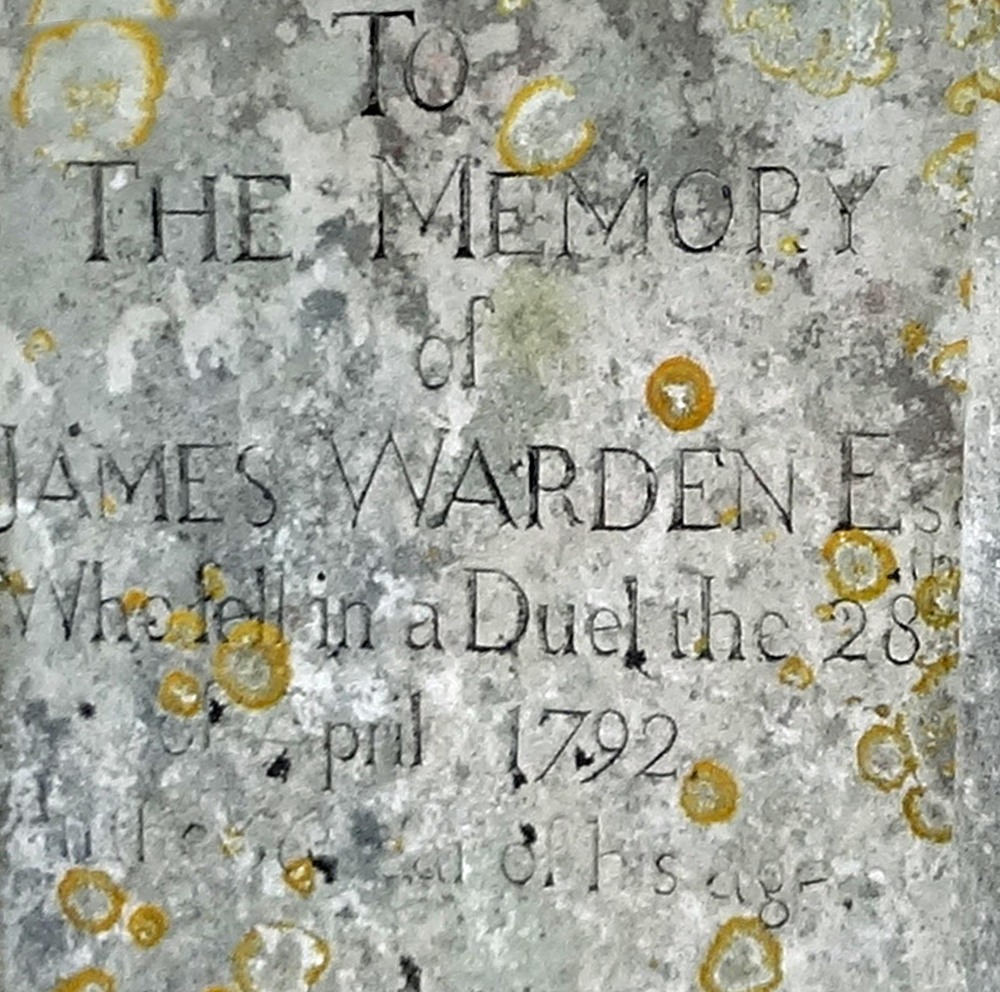A History of St. Andrew`s Church, Charmouth
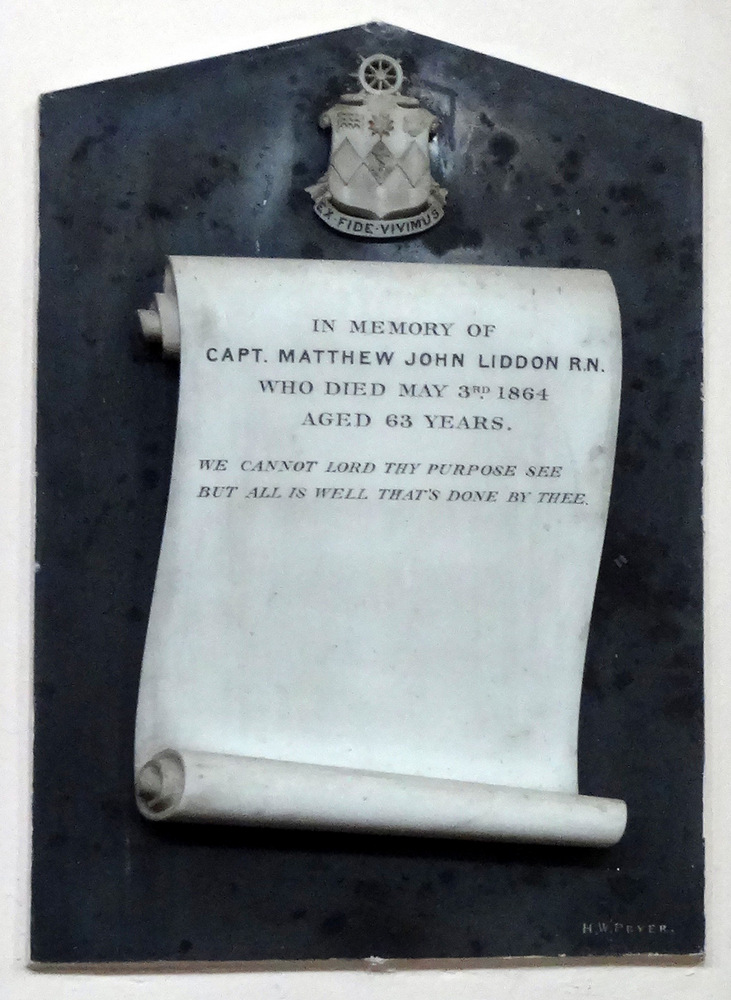

It is James Warden who is to become the Village`s new Lord of the Manor in 1788. It is a puzzle how he was able to afford Charmouth and also Langmoor Manor where he resided. It has been conjectured that it was from prize money for the nineteen Sea Battles he fought in. But the Will for his wife shows them owning considerable property at Wapping, near London. He quarrelled with his son, whom he disinherited, and in his will left the Estate to his wife and upon her decease, upon trust, out of the rents and profits they were to pay to his son, William Weeks Wharton, £20 a year during his life.
In 1789 James won an action against the Rev. Brian Combe and others for removing sand and seaweed from the beach which he owned. His arguments climaxed with a disagreement with a neighbour, Norman Bond that resulted in a duel at Hunter's Lodge Inn with James being shot through the heart and the neighbour fleeing the country to Barbados. The episode is recorded on the large tabletop tomb to James Warden near the entrance to Charmouth Church. On 2nd September 1944 Prudence F.Liddon Tosetti was born, and christened in Charmouth church on 15th October the same year. She was the great great grand daughter of Captain Matthew Liddon, grandson of James Warden and niece of Harry Liddon R.A.F. killed in action on 5th May 1943 whose name is on our War Memorial.

James Warden had an altercation with a neighbouring landowner, Norman Bond. When Warden and Bond met in the street, an argument ensued in which Warden became extremely abusive and threatened to shoot Bond's dogs. Bond demanded Warden apologise, Warden refused, and so Bond challenged Warden to a duel. The time and place was quickly set, the duellers would meet at Hunters' Lodge on the morning of 28 April 1792. [ 3 ]
According to contemporary sources, Warden's wife, Elizabeth, did not oppose the duel, and in fact, seemed to support it. She made no attempt to alert the authorities about the impending bloodshed, even though one of her neighbours was a magistrate . She was the one who had obtained the pistols for the duel. The day of the duel arrived. As Bond had issued the challenge, Warden took the first shot. Bond had a narrow escape as the ball passed straight through his hat. Bond now took his shot - Warden fell to the ground. He had been shot through the heart and died almost instantly. [ 1 ]
Lately was married, at Axminster, Matthew Liddon, Esq, of Weycroft House, to Miss Ann Warden, youngest daughter of James Warden, Esq, of Charmouth
On 2nd September 1944 Prudence F.Liddon Tosetti was born, and christened in Charmouth church on 15th October the same year. She was the great great grand daughter of Captain Matthew Liddon, grandson of James Warden and niece of Harry Liddon R.A.F. killed in action on 5th May1943 whose name is on our War Memorial.

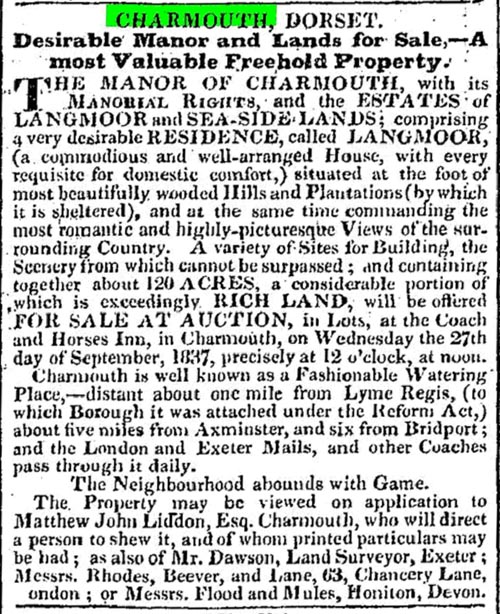
On January 24th 1854 Matthew and Lucy Liddon sell Estate to George Frean of Plymouth for a total of £9100, but after paying off the mortages they receive £5061. James Warden`s son William is still shown as receiving £20 a year from the Estate.

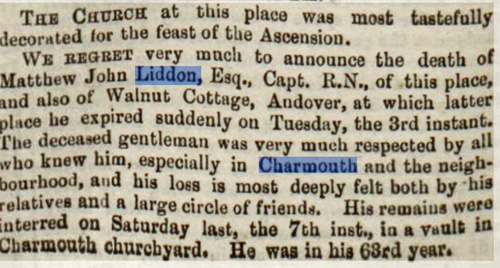
Advert for Ann Liddon (nee` Warden) to borrow £600 against the Manor of Charmouth in Trewmans Exeter Flying Post . She had lost her husband the year before and had 5 children to bring up and educate.
.jpg)

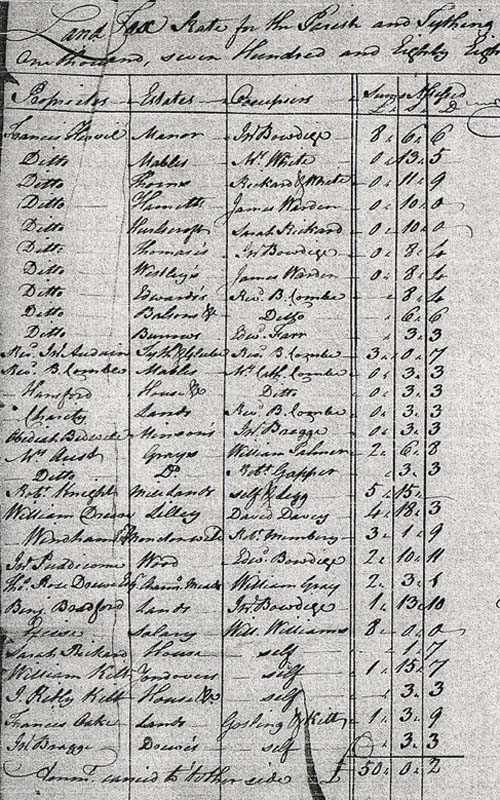
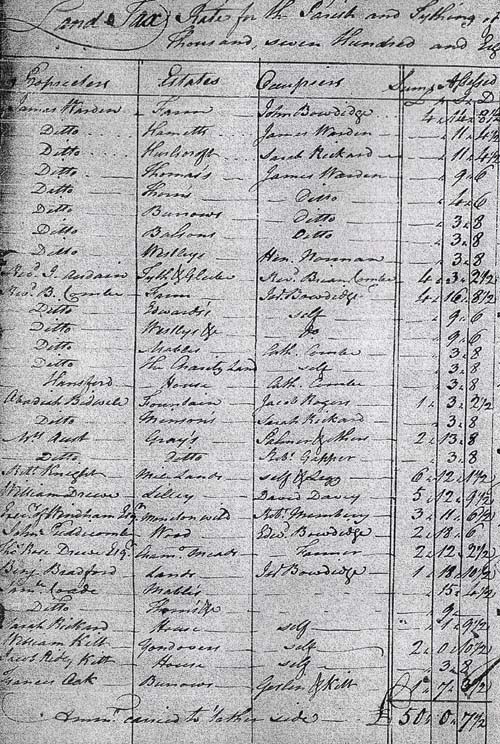
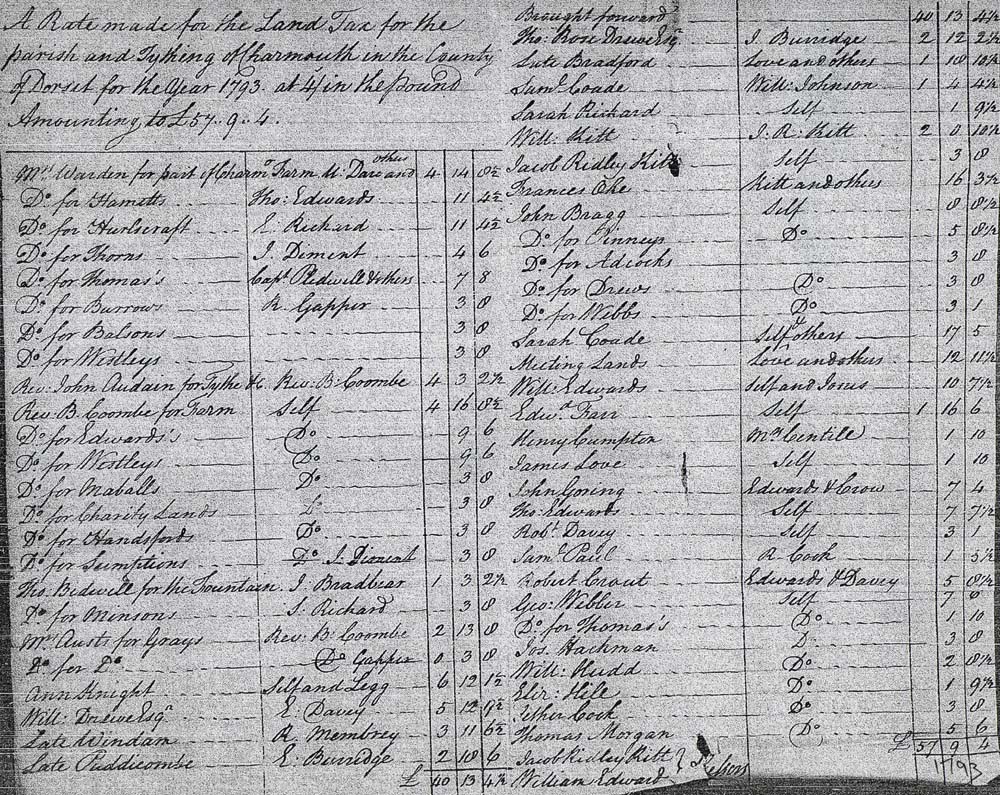
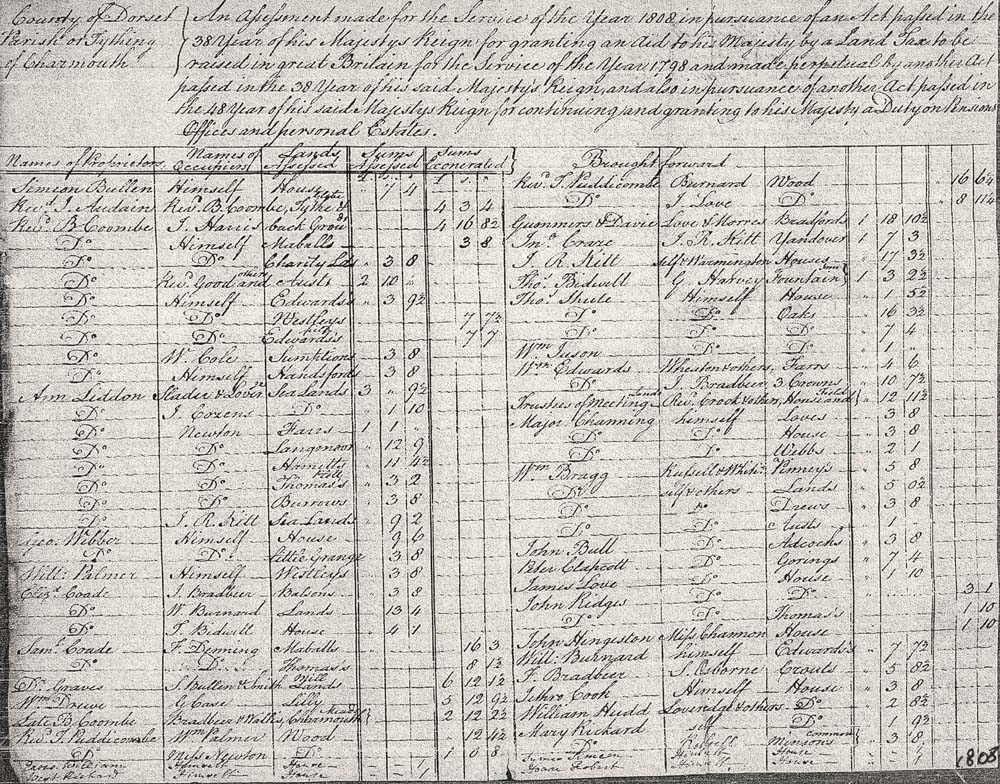
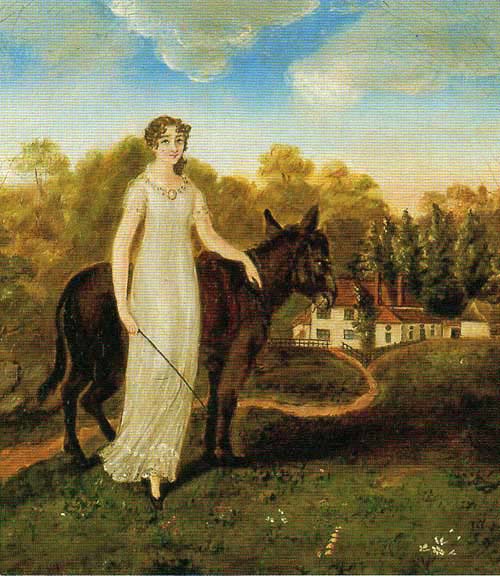

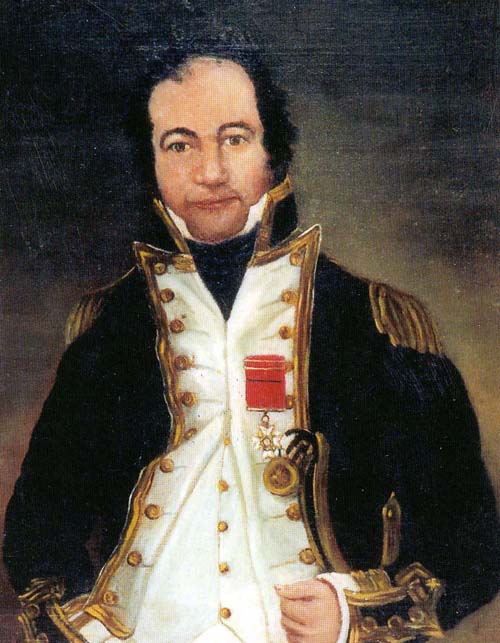
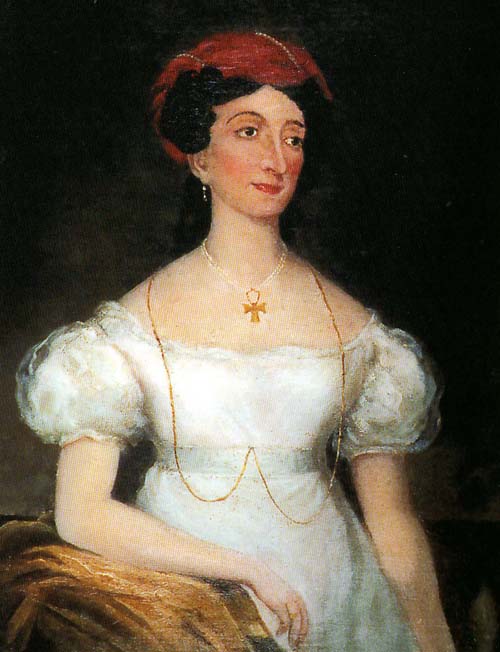
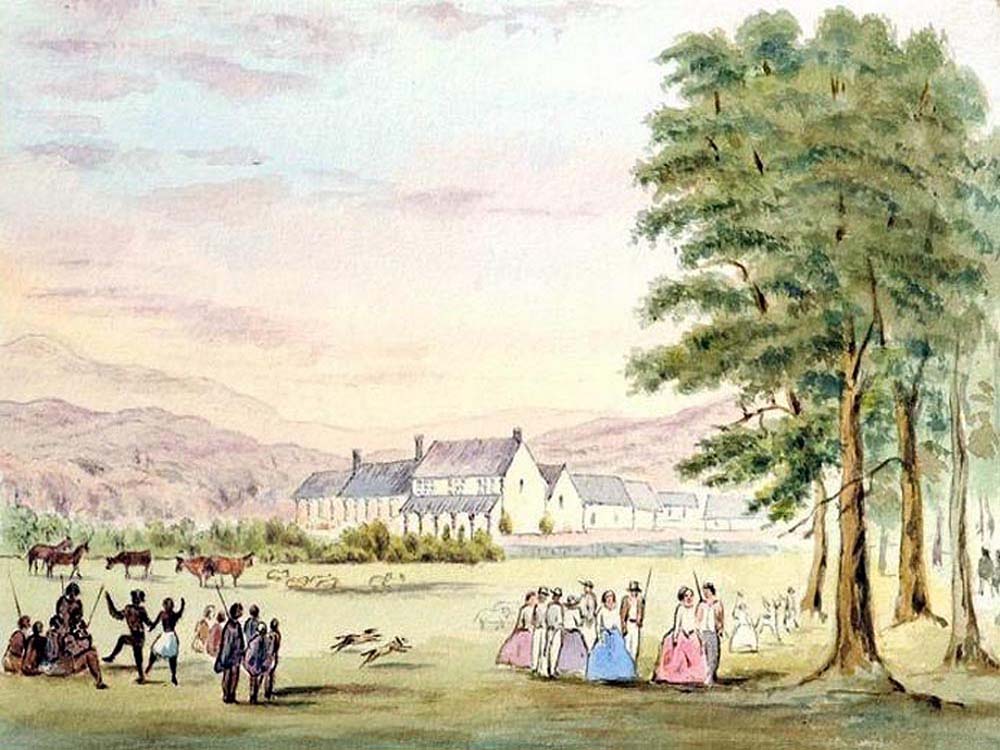
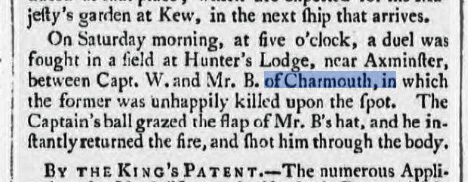

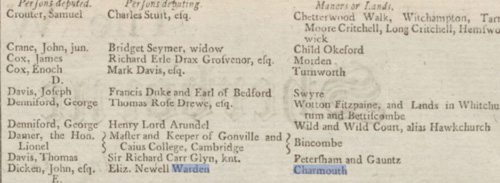
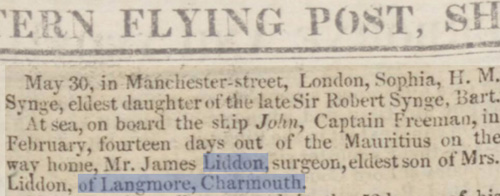
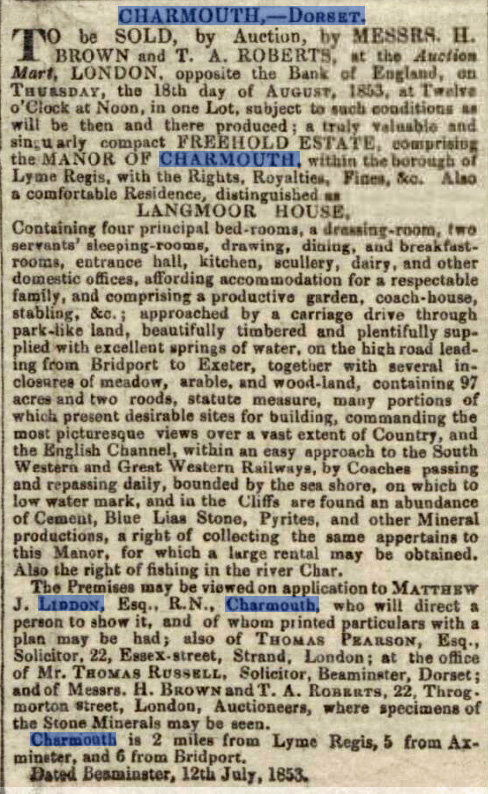
Trustees and friends, the Reverend John Hill, Vice Principal of St.Edmunds Hall in Oxford and William Burnard of Charmouth, Cloth Manufacturer. And my daughter Mary Elizabeth Austin, Widow, undivided moiety of half the whole of the estate called Graston Farm in Burton Bradstock containing about 80 acres lately purchased of John Hussey now in possession of John Warrren as tenant.
All that Farm called Wood Farm in Charmouth and all those lands in manor of Hawkchurch in the occupation of Bernard Cox as tenant. For my grandson Samuel Warren Puddicombe, the fatherless son of said daughter Mary Elizabeth Austin on the age of 21 and not before.
The daughter of my cousin reverend Joseph Domett of Bovey Tracey, Clerk by his first wife. Niece Frances Catherine Hardwicke, the wife of Thoms Brown Hardwicke Esq and daughter of John Warren,mEsq of Lyme Regis.
Will of my late brother, the Reverend Thomas Puddicombe, late if Branscombe, 1825. Lately purchased by the said Thomas Puddicombe of John Hussey.
Messuages, Wharfs , warehouses, lands, eye being in Parish of St. John's , Wapping, Middx. Inherited from late Thomas Puddicombe. Jane Prsetin, daughter of Richard Preston.
Bequeathe to grandson, Samuel Warren Puddicombe my books and good watch, formerly belonged to his grandfather.
Sisters in laws , Susan, Mary and Elizabeth Warren of Lyme Regis, spinsters
Proved in 1831.

.jpg)
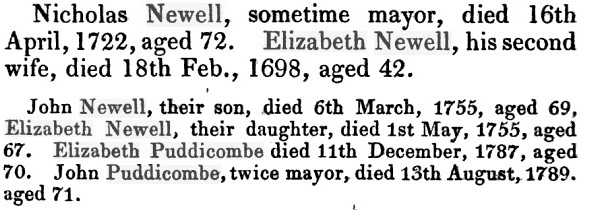



Subscribed to Sermons by J.N. Puddicombe, M.A. Fellow of Dulwich-College; Late of Pembroke-Hall, Cambridge, 1786, PUDDICOMBE, John Newell. London, Cambridge; Subject: religion

Folio 232: James Warden to messers Wharton and Douglas in St. Christopher's. He will ask the government to hold the snow and comments on the legal problems.
Date and place: 1777 Feb 14 St Croix.

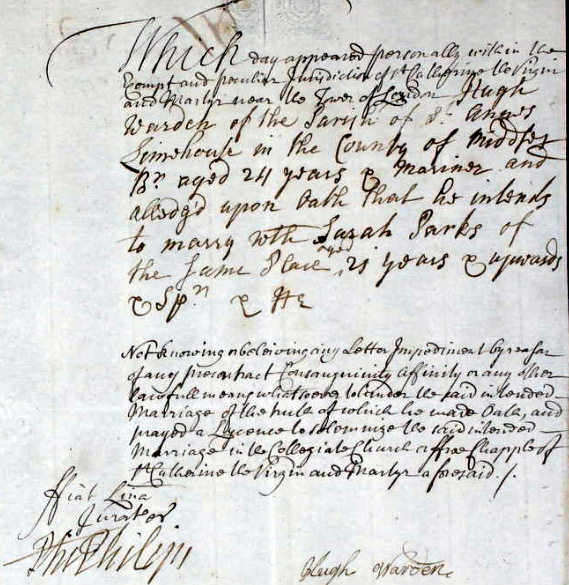
.jpg)
.jpg)

.jpg)
.jpg)

.jpg)
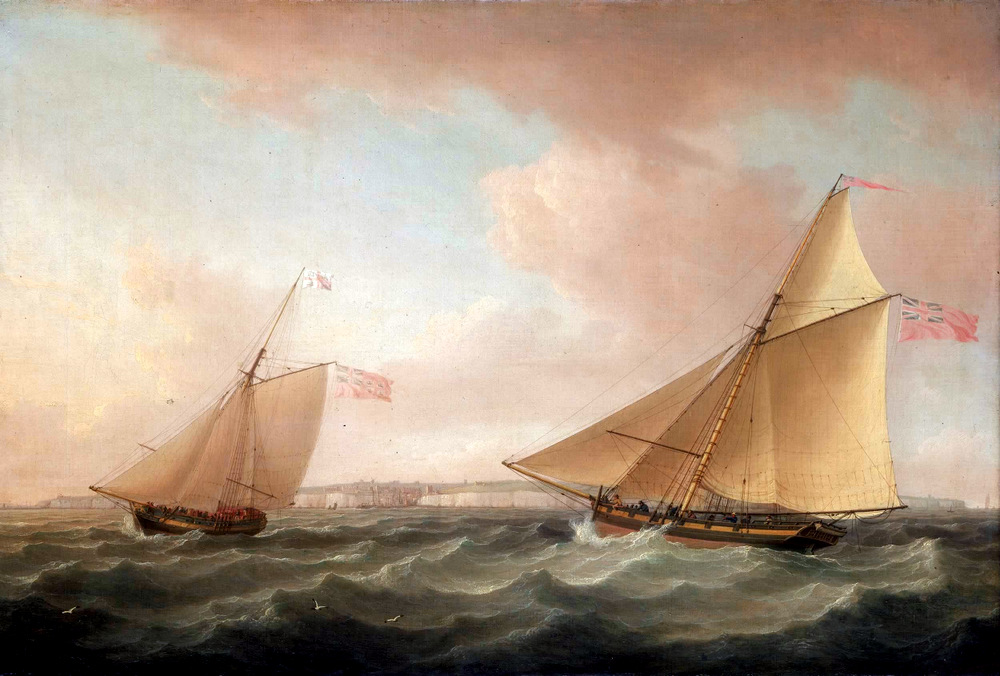
The Sherbourne was built as a revenue vessel for the Customs Service. She was designed by Sir Thomas Slade, the designer of the famous Victory and was built and launched in 1763. After over 20 years of service, Sherbourne was sold in 1784 ~ a remarkably long career for such a small vessel.
Sherbourne was 54' 6" long, 19' wide and had a draught of 8' 11". She carried a compliment of 30 men and was 85 tonnes. Armament consisted of 8 x 3 pounder carriage guns and 10 swivel guns.
Sherborne was commissioned under Lieutenant John Cartwright , later to become a prominent parliamentary reformer, and was assigned to support the work of the Board of Customs by operating against smugglers in the English Channel . Cartwright commanded Sherborne from 7 December 1763 to 14 May 1766. [ 1 ] His area of responsibility was the South Coast of England, including Dorsetshire and Devon . His brother George , when at loose ends, went with him in Sherborne on a cruise out of Plymouth to chase smugglers.
as a coastal Customs officer, apprehending smugglers on the east coast in
command of HM Cutter "Adventure", including his presence in the Edinburgh
port of Leith around 1764/66 (which may become relevant later). Despite
commanding the vessel, it seems he was not certified as a competent Master
and never achieved the rank of Captain.
http://www.ageofnelson.org/MichaelPhillips/info.php?ref=5007
Online accounts of his subsequent wartime gallantry have a whiff of
hyperbole but he appears to have served in the Downs Squadron guarding the
Straits of Dover, protecting British shipping fromFrench privateers and
blockading neutral ships from supplying military goods to French ports.
http://tinyurl.com/Syrett-RNinEW - search for Wells or browse pages 100-109
His most auspicious(?) exploit appears to have been the taking of a Spanish
vessel in 1779, for which a London merchant then sued the Admiralty for the
loss of his legitimate cargo.
http://www.bristolfamilyhistory.co.uk/pistols-at-dawn/
There are various accounts of the duel in which he died, a possible
composite version being that it arose from a quarrel with his neighbour
Norman Bond in which James threatened to shoot Bond's dogs that might have
been taking game from his land. An alternative account was published in
1881 in the Western Antiquary, which also includes the full text of the
awful poem on his tombstone, allegedly penned by his wife Eliza, together
with an OTT inscription suggesting that Eliza played the merry widow before
eventually finding redemption just before she died (though I suspect she may
well have written that herself).
http://www.forgottenbooks.com/readbook/The_Western_Antiquary_v1_1000544553#99
James WARDEN's PCC will of 1792 reveals not only that he effectively
disinherited his son William Weekes Wharton WARDEN to the tune of just 20
pounds a year, with strings attached, but that he disowned and humiliated
"my daughter Susannah Parks Liddon wife of William Liddon one shilling
only". (I have seen that wording before, in a Devonshire STOOKE will: "to
the [un-named] wife of my deceased brother one shilling only". Was that a
commonly used device?) The main beneficiary was his wife Elizabeth who got
all the Charmouth properties, the residual beneficiary being his younger
daughter Ann, wife of Matthew LIDDON of Axminster. It would be interesting
to know why James fell out with two of his children. By contrast,
Elizabeth's PCC will of 1798 demonstrates her apparently cordial
relationship with all three of her step-children.
Ancestry also has the 1856 PCC will of William Weekes Wharton WARDEN of
Chichester, Commander in the Royal Navy. in which his beneficiaries are his
wife Elizabeth and daughters Sarah Ann WARDEN and Harriet Elizabeth wife of
Samuel FORWARD "for her separate use free from the debts of her present or
any future husband". A few years earlier, the 1851 census of Chichester has
William Warden (80, Commander RN, born Edinglevigh, Scotland), Elizh Warden
(68, wife, born KENT) and J A Warden (actually S[arah] A[nn] Warden, dau, 40
unm, born Axminster, Devon). I have not found any record of William's
birth/baptism but his various 1856 death notices on BNA give his age as 90,
implying born ca 1766, and Edingvleigh is probably Edinburgh, consistent
with his father's presence in the nearby port of Leith about that time. In
1851 Samuel and Harriet FORWARD were living in Charmouth, he 60, born
Axminster, army half pay, she 43 born St Oswyth, Devon, but later censuses
correct her birthplace to St Osyth, Essex. The Warden/Liddon web page has
William married to a different wife Mary Slinn. Was she a first wife?
Finally, I concur with Julia's comments about James's first wife
Betty/Elizabeth but still find no record of such marriage prior to the birth
of their eldest child.
I don't intend to pursue this disfunctional family any further so had better
sign off now. The bottom line is that James Warden was not a nice man and
probably got what was coming to him, but is a wonderful character to have in
any family tree.
Regards - Martin Beavis
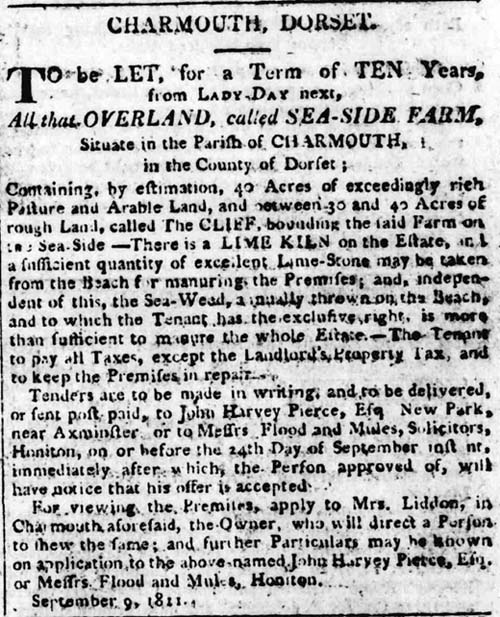
To be Let, for a Term of Ten Years from Lady Day next.
All that Overland, called Sea - Side Farm,situate in the Parish of Charmouth, in the County of Dorset.
Containing by estimation, 40 Acres of exceedingly rich Pasture and Arable Land, and between 30 and 40 Acres of Rough Land, called the Cliff, bounding the said Farm on the Sea-Side - There is a Lime Kiln on the Estate, and a sufficient quantity of excellent Lime-Stone may be taken from the Beach for manuring the premises, and, independent of this, the Sea Weed, annually thrown on the Beach, and to which the tenant, has the exclusive right is more than sufficient to manure the whole Estate. - The Tenant to pay all the Taxes, except the Landlords Property Tax and to keep the Premises in repair.
Tenders are to be made in writing, and to be delivered, or sent post-paid, to John Harvey Pierce, Esq. New Park, Near Axminster, or to messrs. Flood and Mules, Solicitors, Honiton, on or before the 24th day of September inst. and immediately after which, the Person approved of, will have notice that his offer is accepted.
For viewing the Premises, Apply to Mrs. Liddon, in Charmouth aforesaid, the Owner, who will direct a Person to show the same, and further Particulars may be known on application to the above named John Harvey Pierce Esq. or Messrs. flood and Mule, Honiton. September 9, 1811.
.jpg)

